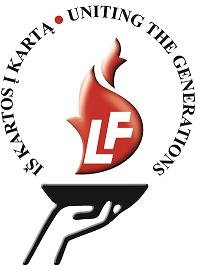Connecticut
Connecticut is a small state and although the number of Lithuanians is only ~33 000, this means almost 1% of the entire population (the largest share among US states). Most of them are descendants of Lithuanians who immigrated before World War 1 to work at the then-burgeoning Connecticut factories.
Lithuanian churches built in the 1900s-1920s still tower among historic townhouses. These churches are massive; built in various revival styles, they look as if teleported from a Lithuanian countryside. The size makes you think they have been constructed for an entire town of tens of thousands rather than a single minority. They are surrounded by equally old parish houses and Lithuanian schools. Interestingly, these were established at roughly the same time as the first official Lithuanian schools in Lithuania itself where Lithuanian language has been banned by the ruling Russian Empire until 1904 (something that surely played a role in increasing emigration to the USA and Connecticut in particular).

Waterbury Lithuanian school entrance adorned by Vytis
In addition to the churches, there are Lithuanian monuments in Connecticut, especially the massive traditional Lithuanian sun-crosses that combine Christian and pre-Christian messages. There are also old clubhouses and a single Lithuanian cemetery. The cemetery is located in Waterbury, where there is an entire district of Lithuanian buildings. More early-20th-century Lithuanian heritage exists in Hartford, New Britain, Ansonia, Bridgeport, and New Haven.
After World War 2, Connecticut received a massive center of worldwide Lithuanity in its Putnam village. There, a Lithuanian female convent, a large Lithuanian-American art museum, Lithuanian-American library, and Lithuanian-American sculptures attract many Lithuanians and non-Lithuanians alike.

Lithuania-themed stained glass windows at the Putnam convent
However, in general, after the massive pre-WW1 "First wave of immigration", Lithuanians ceased to migrate into Connecticut in large numbers. Small cities famous for their Autumn leaves were not as attractive as Chicago or New York. Perhaps this has saved the old churches: they haven't been rebuilt into modern-yet-less-appealing ones, still engulfing the visitor with a nearly century-old splendor of stained glass windows. Unfortunately, a major church-closing spree ~2020 led to a quick closure of many Lithuanian churches, although buildings do survive.
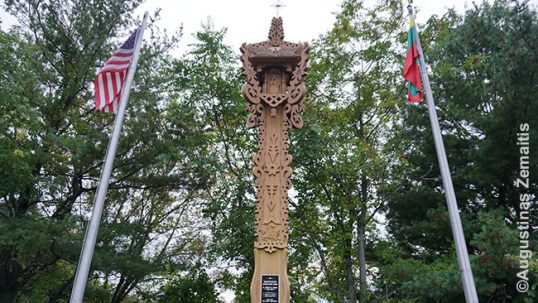
A massive Lithuanian chapel-post in New Britain, the city where the famous anti-Soviet partisan A. Ramanauskas-Vanagas hailed from. Destroyed ~2023 after the diocese closed down and sold the nearby Lithuanian church
Putnam area - Lithuania outside Lithuania
Putnam town may have merely 9000 inhabitants and relatively few Lithuanians, yet it had become one of the most important Lithuanian-American centers.
The Lithuanian sites in Putnam grew around the Lithuanian female convent of Immaculate conception. Originally established in 1936, it gained importance after the Soviets occupied Lithuania in 1940 and banned the monastic life there. At that time, the convent effectively became independent and sought to promote Lithuanian cause in addition to the religious cause. Lithuanian-Americans thus rallied around the convent, using their donations and labor to help it become a vast Lithuanian space. Among those working here were some of the most famous Lithuanian-American artists, therefore, Putnam area became a true haven of top Lithuanian-American art.
The convent is centered around a chapel (1954) created by a famous Lithuanian painter Kazys Varnelis. Its stained-glass windows are especially Lithuanian in design, showing Lithuanian ethnic symbols and Lithuanian locations strong in Maryan veneration (the churches and the coats of arms of these locations are depicted, among other symbols). The altar of the chapel is of the unique Varnelis's style. Near the entrance stands the statue of Our Lady of Šiluva (representing the earliest popular Maryan vision in Lithuania and Europe). It was created by a famous Lithuanian-American sculptor Vytautas Kašuba (the mosaic behind the sculpture was created by his wife Aleksandra Kašubienė).

Putnam convent chapel interior
The massive convent building adjoining the chapel once was full of Lithuanian nuns. However, after the independence of Lithuania opened up monastic life there again, the Putnam convent did not attract new nuns and thus more and more of the rooms were used for other purposes, such as recollections of lay people. In any case, the key Lithuanian parts of the convent remained, including the Lithuanian museum and Lithuanian library, as well as Lithuanian artworks exhibited in the corridors.
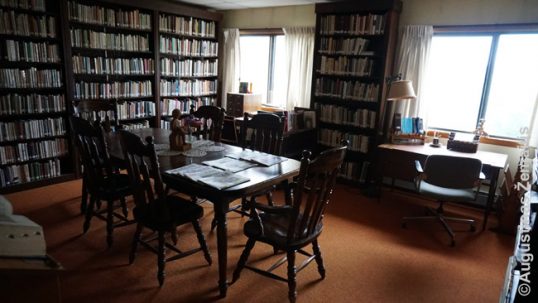
Putnam convent Lithuanian library
The Lithuanian museum excels in concise-yet-beautiful English introduction to the most famous and unique elements of Lithuanian Catholic history and culture: the Šiluva Maryan vision, the blessed Jurgis Matulaitis, UNESCO-recognized Lithuanian wooden crosses, rūpintojėlis (traditional Lithuanian sculptures of worried Christ), the Divine Mercy image that originates in Lithuania, etc. The museum's collection goes beyond the faith, however.
Among the exhibits in the museum is the famous "Siberian book of prayers", published by the convent's nuns in 1959. This book by Adelė Dirsytė was written after her exile to cold and dreary Siberia by the Soviet occupational regime for her disapproval of communism. She wrote her hopes and prayers onto a manuscript in 1953 but only by 1959 could it go beyond the Iron Curtain (the author deceased in 1955 unable to withstand the harsh conditions after being moved to a gulag). The Putnam Lithuanian nuns were instrumental in publishing this prayer book, which has been a major global success. It had been translated into many languages (even Chinese) and had a massive circulation (450 000 Dutch books alone), as well as many issues (5 times issued in Germany), helping the world to learn about both the tragedy and determination of the Lithuanian nation. This is likely the most widely published Lithuanian book.
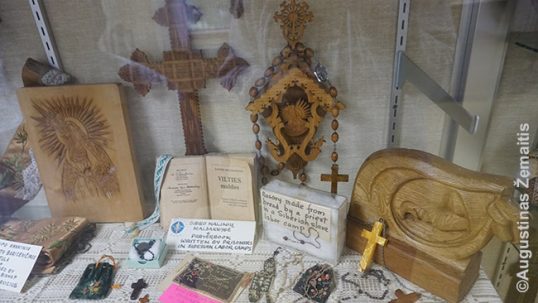
The Siberian book of prayers and other things of the Soviet-expelled Lithuanians in the convent museum. All the translations of the book are also available.
In addition to the Lithuanian-American artworks, the monastery (and its museum) has even more traditional ethnic artworks form Lithuania. During the Soviet occupation of Lithuania, many Lithuanian-Americans felt it as a part of their mission to save such works by bringing them into the USA. For example, in the entry hall of the monastery stands a traditional Lithuanian wooden wayside cross smuggled from the Soviet-occupied Lithuania where such crosses were often destroyed by the atheist regime.
In addition to the buildings, the convent has rather massive grounds. In the forest near the grounds stands what is one of the most interesting and unique Lithuanian sites in the USA: Mindaugas castle built in a forest by a Lithuanian priest Stasys Yla who escaped into the USA after being a prisoner of the Nazi Stutthof concentration camp.

Mindaugas Castle in Putnam
Stasys Yla chosen the site after discovering a peculiar stone in the forest and built his castle around that stone. In its form, the castle is meant to remind the crown of King Mindaugas (the only Christian king of Lithuania, who lived in the 13th century). The castle interior was decorated by Lithuanian-American artists such as Aleksandra Kašubienė in mosaics and stained glass windows: those also remind of the King Mindaugas, his wife, and his sons.
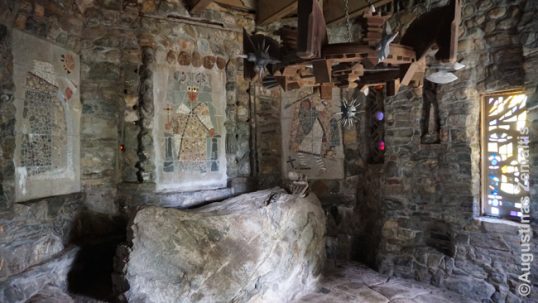
The interior of the Mindaugas castle in Putnam with a mosaic of Mindaugas (left) and the stone aroudn which the building was constructed (center)
While the castle was built by priest Yla as a hobby and is not a chapel, currently it is sometimes used for prayer and is especially loved by the youth, for whom the rather mystical nature of the castle-within-a-forest may appeal more than regular chapels or churches.
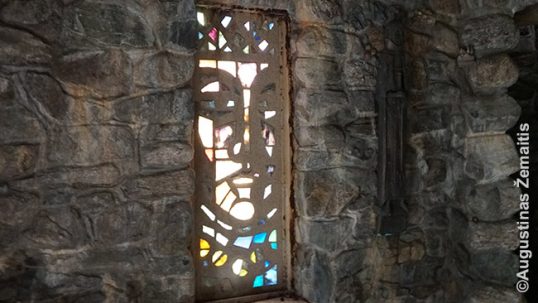
One of the mystical stained glass windows within the Mindaugas castle of Putnam
The keys to the castle interior are held by the nuns of the convent. The convent itself is generally always open and may be visited. The convent grounds are not fenced and can be visited even without meeting the nuns.
Between the convent and Mindaugas Castle lies the small Gate of Heaven cemetery. Only the nuns, their relatives and the sponsors of the convent are buried there. However, such sponsors includes many famous interwar Lithuanian figures, such as Magdalena Avietėnaitė, who had an almost unprecedented diplomatic career for a woman anywhere in the world at that time (famously, she was not given a higher diplomatic rank solely because the prime minister believed that "the Western world would not understand Lithuania if it would appoint a woman to such a rank"). Juozas Brazaitis (Ambrazevičius), the prime minister of the anti-Soviet 1941 June revolt, also used to be buried there (however, he has since been reburied in Lithuania). Of course, Stasys Yla's grave is also in Putnam.
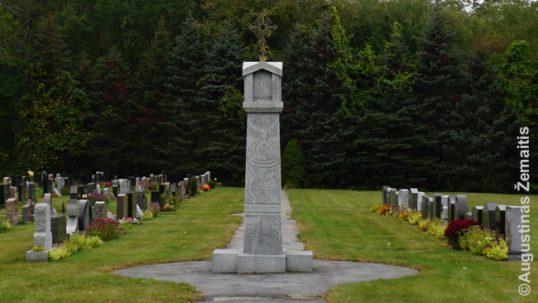
Gate of Heaven Cemetery in Putnam
The center of the Gate of Heaven Cemetery is marked by a stone monument with such Lithuanian phrases as "Don't forget us, oh the Highest one, and don't forget our dear Fatherland" ("Neapleisk, aukščiausias, mūsų ir brangios Tėvynės") by the famous Lithuanian poet Maironis. The fatherland mentioned here is, of course, Lithuania rather than the USA.
Also at the cemetery stands a large Lithuanian sun-cross that was originally located in New Haven near its now-closed Lithuanian church (see below). As one of the most well-surviving Lithuanian religious institutions, Putnam monastery collects Lithuanian monuments from the Lithuanian institutions that are closed down (especially the churches).
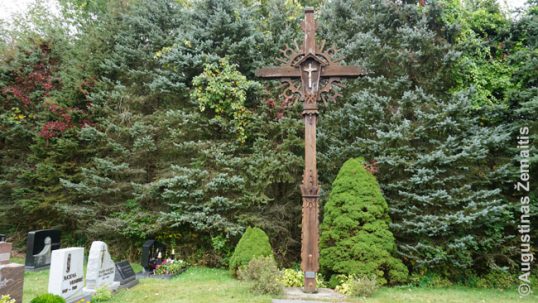
The Lithuanian sun-cross relocated to Putnam from New Haven
On the other side of the Mary Crest Dr from the convent stands yet another one of the America's top Lithuanian sites - the Lithuanian-American Cultural Archive (Museum). The archive is open to the public as a museum which has a great and diverse collection of Lithuanian-American art, including paintings, sculptures, and crafts. Famous Lithuanian-American artists such as Vytautas Kašuba, Kazys Varnelis, Kazimieras Žoromskis, and Vytautas Kasiulis are represented (the latter two are famous enough to each have a museum dedicated to him in Vilnius, the capital of Lithuania). Most of the art dates to the 1940-1990 era. Some of the art is dedicated to the Soviet occupation of Lithuania and its horrors. The other art tries to convey the beauty of Lithuania that was inaccessible to the artists or depicts the scenes of Lithuanian Medieval history that served as an inspiration to them. Yet other art is not related directly to Lithuania but was still created by the top Lithuanian-American artists.
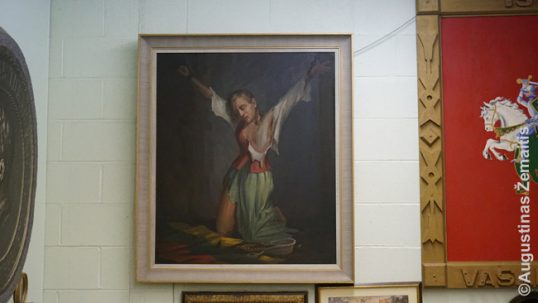
Crucified Lithuania, one of the Lithuanian artworks at the Lithuanian-American Cultural Archive
The Lithuanian-American Cultural Archive is open by appointment. The building also includes a massive Lithuanian library. Even if you don't want to read these books, ask to access it, as some of the better artworks are on the walls of the library rather than in the museum.
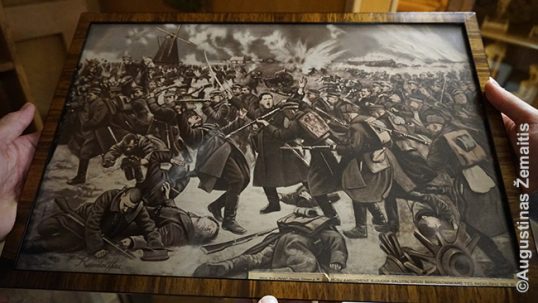
Lithuanian routing out the Bermontians in the wars of independence (ALKA collection)
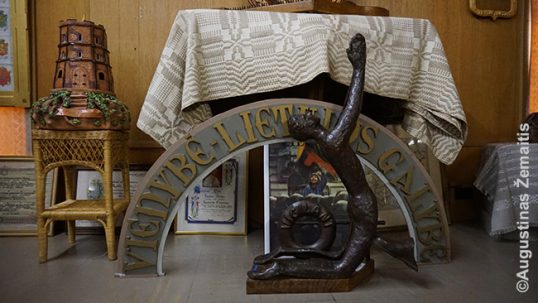
Sculpture of S. Kudirka. A topic in numerous ALKA paintings, he was the Lithuanian sailor of the Soviet navy who defected to the USA yet was given back to the Soviets, drawing many Lithuanian-American protests.

A historical painting by Kazimieras Žoromskis
The Lithuanian-American Cultural Archive collection was largely amassed through donations and, currently, through legacies, as the descendants of Lithuanian-Americans who no longer speak Lithuanian and have little knowledge in Lithuanian art tend to donate all their dead parent's or grandparent's Lithuanian properties to a key Lithuanian institution, such as the Lithuanian-American Cultural Archive. The Archive reviews these donations and, if it already has similar books, re-donates them to those who ask (e.g. libraries in Lithuania). Artworks, on the other hand, are not re-donated, forever staying in what turned to be one of the key Lithuanian museums in the Americas.

Miniatures of traditional Lithuanian woodcarved crosses and chapel-posts in ALKA. Many Lithuanian-Americans have such crosses at home as symbols of Lituanity.
The Archive was created by Monsignor Francis Juras, who used to be pastor of the Lithuanian parish in Lawrence, MA. He transferred ownership of ALKA to the Lithuanian Catholic Academy of Science. The institution is housed in a rather simple house that has been decorated with Lithuanian symbols. The wooden carvings have been brought in from a closed Lithuanian National Club in Boston; there are also the Columns of Gediminas and a chapel-post.

The exterior of ALKA
The nuns still care for the Jurgis Matulaitis Home for senior citizens somewhat away from the monastery. Initially started as an assisted living facility for Lithuanian-American seniors in 1968, the Home now has clients of all ethnicities. However, the interior is still pretty much Lithuanian with Lithuanian artworks on the walls. The Matulaitis Home's chapel was created by V. K. Jonynas, a famous Lithuanian-American church interior designer. However, it lacks visibly Lithuanian details. Jurgis Matulaitis himself was a Lithuanian archbishop who attained the blessed status (one of just several Lithuanians to do so). His name and image are popular in Lithuanian-American religious institutions.

Matulaitis Home entrance with Lithuanian sun-cross on the top of the name
Jurgis Matulaitis is also famous as the effective re-founder of the order of the Maryan priests (at one time, he was the only surviving member of this ancient order, yet the order came to flourish again due to his work and now has many members in America and beyond). Maryan priests had their own convent near Putnam in Thomson, which has also served as the Marianapolis gymnasium for Lithuanian-Americans. Lithuanians from all over America would study in this boarding school, which had massive grounds and many buildings, such atmosphere helping them to retain their Lithuanian language and culture. The school is still open, albeit transferred to lay people in the 2000s and now accepting students of all nationalities (as the school is prestigious, there are many students sent in by rich Asian families).
The school's Lithuanian history is still visible, however. In the Marianapolis school ground stands the Grave of priest Jonas Navickas, instrumental for the school's history; it is one of the largest grave memorials for a Lithuanian in America.
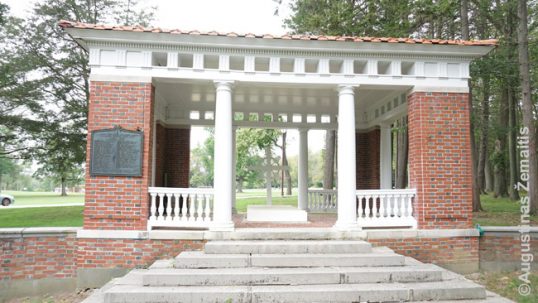
Priest Jonas Navickas grave
In the massive Marianapolis school chapel there are Lithuanian exhibits, Our Lady of Vilnius painting and, the most strikingly, a large painting of Jurgis Matulaitis over the altar. This is actually the same painting that hanged in Rome during his beatification ceremony.

Marianapolis school chapel with a massive painting of Jurgis Matulaitis
Maryan priests were actually those who helped the Lithuanian nuns to settle in Putnam, and some of the older buildings of the school grounds were used as the nuns' first convent before the current land was acquired.
Waterbury Lithuanian district
The city with most Lithuanians in Connecticut is Waterbury (2 500 out of 100 000). It has an entire Lithuanian district with a large red St. Joseph church, where a traditional wooden "chapel-post" stands in front (a form of ethnic art). The interior has stained-glass windows (with Lithuanian-inscriptions) that are among the most impressive among the East Coast Lithuanian churches. Originally, the interior of the church was even more opulent but it was simplified by overpainting much in white after the Vatican II church reforms. Moreover, originally, two Baroque Revival Towers were planned for the Waterbury Lithuanian church which would have made it definitely the most impressive Lithuanian church in Connecticut. However, the community chose to build a massive Lithuanian school instead of the towers. The cornerstone of the church has a Lithuanian inscription "Szvento Juozupo lietuviszka bažnyczia" - this inscription still used the old semi-Polonized Orthography for the Lithuanian language with "sz" for a modern Lithuanian "š" and "cz" for "č".
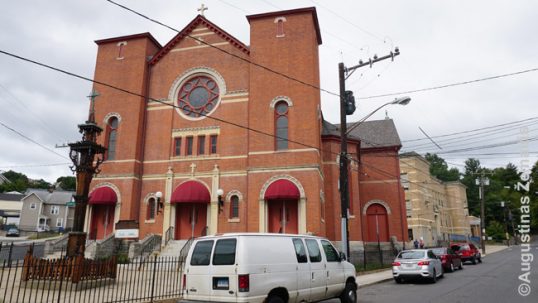
Waterbury Lithuanian church

An example of the stained glass windows with Lithuanian inscriptions

A close-up of Waterbury Lithuanian church stained glass window with Lithuanian inscriptions. Every Connecticut church has such elaborate Lithuanian stained glass windows.
Two rooms at the sides of the church work as improvized Lithuanian museum, showing Lithuanian memorabilia and the parish history. The original Lithuanian museum used to be at the Parish house, however, it was closed down by the parish's non-Lithuanian priest in 2017 and sold. The parish house, which once housed the masses in winter, is now largely devoid of Lithuanian atmosphere. As not all of the museum's exhibits fit into the two small rooms, many are crumbling in the church basement.

The Lithuanian parish house of Waterbury
The first Lithuanian mass has been celebrated in Waterbury in 1894 (also the first in Connecticut) in a house not far from the church. The church was built in 1904-1905, the oldest Lithuanian church in Connecticut. Next to the church an elaborate Lithuanian school building (1925) stands, now closed, but still adorned by Vytis in front, as well as Lithuanian inscriptions "For God and country" (architects Adam O'Connel, W. Show).
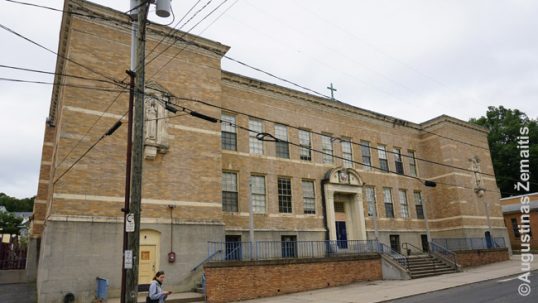
Waterbury Lithuanian school
The nearby Green Street once had 3 Lithuanian clubs popularly named after the street number of their houses: one leftist (103), one nationalist (48), and one Catholic (Knights of Lithuania). All three are closed by now, with the Knights of Lithuania club surviving the longest and getting closed only ~2020 as the parish sold their building.
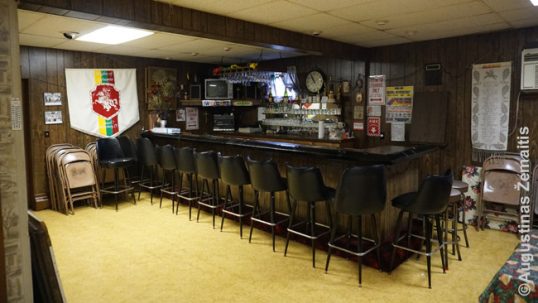
The interior of Lithuanian Catholic Knights club in Waterbury before its closure
The leftist club closed the first (as the Soviet persecutions in Lithuania made the socialism less popular), only the Lithuanian word "VENTA" above the building entrance still reminding of its previous location (ironically, now the building houses a Pentecostal church).
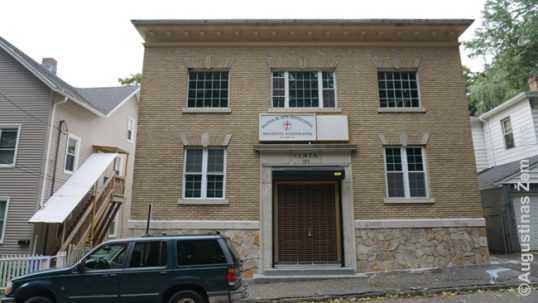
The former leftist Lithuanian club "Venta" of Waterbury
The nationalist club burned down in the 2000s, however, advertisements on its former lot still offer to rent the garages to help it rebuild.
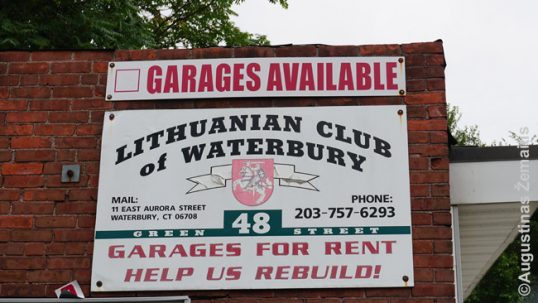
The site of the burned-down Lithuanian club in Waterbury
The slow demise of Waterbury Lithuanian district began in 1955, when a massive flood hit, killing 29 locals. A memorial for victims of the Waterbury flood was erected in the district in 2012. The memorial lists 29 names of the victims with the majority of the surnames being Lithuanian. However, even more victims could have been Lithuanians, as many Lithuanians at the time used anglicized surnames after emigration.
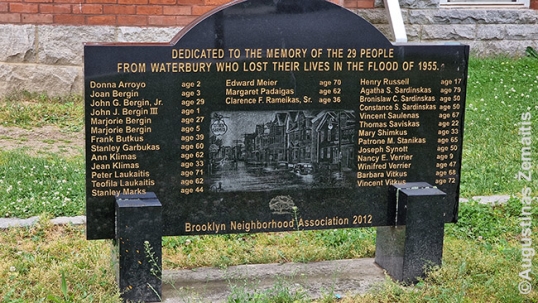
Waterbury Lithuanian district flood memorial
Since 1955, Lithuanians gradually moved out of the district to the suburbs. While some of them still returned to the Lithuanian institutions such as the church or the club, it was a far cry from the lively Lithuanian district it once was, while the raised-in-suburbs younger generation rarely returned at all. The district also became unsafe. ~2020, most of the Lithuanian buildings of the district were sold to non-Lithuanians, although at the same time a group of active Lithuanians began attempts to revitalise the district by adorning its streets with Lithuanian flags and celebrating the traditional Lithuanian festival of Joninės (midsummer) here annually. These attempts coincide with the general US trend of downtown gentrification.

Lithuanian flag in the Waterbury Lithuanian district
Beyond the Lithuanian district, Waterbury has a Lithuanian cemetery (est. 1902), the only one in Connecticut. Established by the atheists (there is even a gravestone with hammer and sickle), it was later blessed and used by the Catholics as well. The later graves often have Lithuanian ethnic symbols, such as Vytis, and many Lithuanians who fled the Soviet occupation of Lithuania are also buried there. The inscription at the entrance declares it to be (in archaic Lithuanian) "A free graveyard of the unified Lithuanian societies" ("Lietuviu suvienitu draugiyu laisvas kapinynas").
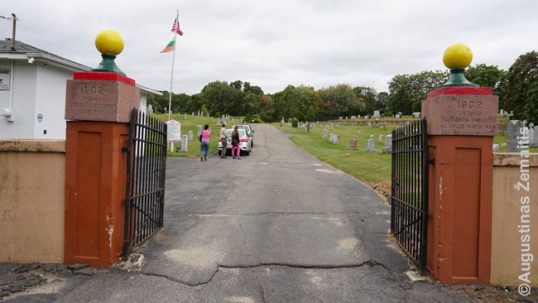
The Lithuanian entrance to the Waterbury Lithuanian cemetery
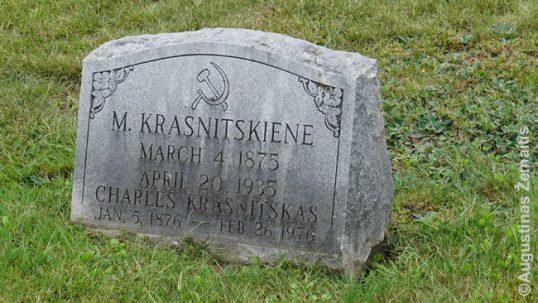
A grave with hammer and sickle in the Waterbury Lithuanian cemetery (on a pre-WW2 1935 grave)

A Waterbury Lithuanian cemetery grave with ethnic symbols
The cemetery administration building now serves as the clubhouse of the burned-down Lithuanian national club. The cemetery entrance gate is painted in the Lithuanian flag colors and a Lithuanian flag (together with the US one) is perennially waving above the cemetery.
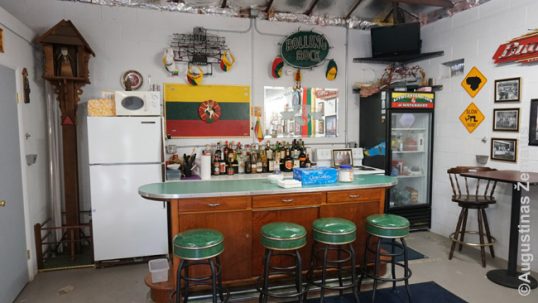
Interior of the Waterbury Lithuanian cemetery club at the cemetery
Away from the center, Waterbury has Brooklyn Bakery in one of its shopping malls. While the bakery is no longer Lithuanian-owned, it was once located in the Lithuanian district and it still has the historic photos of Lithuanians working at its former place inside, as well as an original table.

An image of Lithuanian workers of the Brooklyn Bakery before WW2
At its peak, Waterbury area had some 10 000 Lithuanians, 6 000 of them members of the Lithuanian parish.
Hartford Lithuanian church and monuments
Lituanity still exists in the state capital Hartford (pop. 124 000). Red gothic revival Holy Trinity Lithuanian church slightly reminds in its form the old French cathedrals. A nearby old house is a parish home; both US and Lithuanian flags are waving in front of it. The land has been purchased in 1900, the church constructed 1915-1928; parish school was open until 1964.

Hartford Lithuanian church and parish house with a Lithuanian flag
The church is two-floored, with the lower floor used as a parish hall for more secular matters. It also hosts lots of Lithuanian memorabilia.
The main hall has stained-glass windows with Lithuanian names on them and many plaques, commemorating Lithuanians, including the former priest Albin Gurklis, the Hartford Lithuanians who served the US armed forces, and more.
The church is the closest church to the Connecticut state capitol. The church history may be read by using the specially designed QR codes.
Historically, a Lithuanian district stood nearby, however, much of it homes were demolished during an urban renewal campaign ~1960s, replaced by parking lots serving the city downtown. The remainder, Lithuanian church including, was inscribed into NRHP as a historic district.
Outside of the church, a wooden traditional Lithuanian cross stands. It incorporates the image of Our Lady of Šiluva (a Maryan vision in Lithuania) in its design, with the word "Šiluva" inscribed.

Hartford Lithuanian hall on the ground floor / basement of the church, an example of the Lithuanian ethnic halls which every Lithuanian-American church has. It is as large in area as the church ("religious hall") itself that is above it.
An even bigger Lithuanian traditional artwork of the UNESCO-inscribed Lithuanian cross-crafting art used to be located at the Hartford cathedral itself - a Lithuanian chapel-post. It has been constructed as part of a campaign by the Lithuanian priest John Rikteraitis to build numerous such Lithuanian shrines in Connecticut, mostly in front of the Lithuanian churches. Sadly, that shrine was demolished ~2020.
Another former Lithuanian hub in hartford was the Lithuanian Citizens Club located in a historic building of Hartford Lyceum. That massive building was owned by Lithuanians ~1940-1981. Now it serves as a conference center.
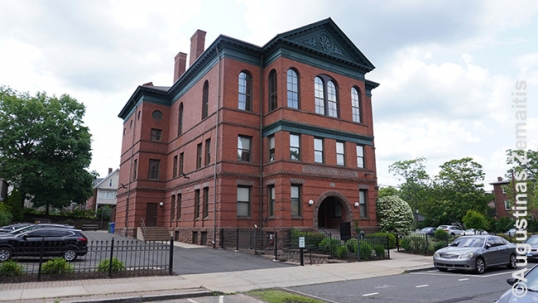
Hartford Lyceum (foirmerly Lithuanian Citizens Club)
New Britain Lithuanian sites
Romance revival New Britain St. Andrew Lithuanian church (396 Church Street) dates to 1911. The interior of the church was especially pretty, as it was constructed to be a visual church that could show often illiterate Lithuanians of the early 20th century the stories of the Bible. Unfortunately, the church was closed in the early 2020s, and the interior gutted.

New Britain Lithuanian church
The church closure also led to the demolition of Connecticut's primary Lithuanian memorial that used to stand on the church grounds on the opposite side of the road. That was a Lithuanian traditional wooden chapel-post (1995) surrounded by Lithuanian and US flags. It was arguably the prettiest of the Rikteraitis's commissioned Lithuanian shrines. It incorporated not only religious but also Lithuanian ethnic motifs, including the coat of arms, the Cross of Vytis and the ethnic patterns which are created of wood. Inside the "chapel" at the top is Rūpintojėlis, a traditional Lithuanian design of a sad Jesus. The chapel-post had been erected for the 100 anniversary of the church and was designed by Gertrūda and Joseph Ambrozaitis.
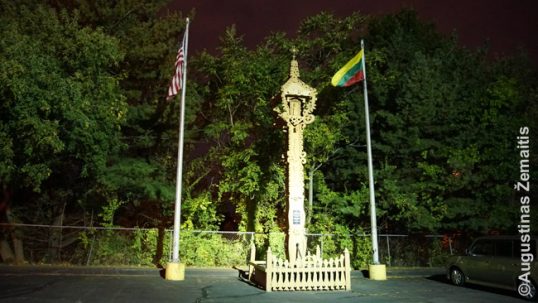
Lithuanian chapel-post at New Britain
The New Britain church is especially famous for having been a location where a leader of Lithuanian anti-Soviet partisans Adolfas Ramanauskas "Vanagas" was baptized. His parents, like many Lithuanian-Americans who escaped the Russian Imperial regime that occupied Lithuania in 1795-1915, chose to return after Lithuania became independent in 1918, with Vanagas still being a toddler. As fate decided, however, Vanagas was to suffer an even more terrible Soviet Russian occupation and was killed by the Soviets (who have also punctured his eye and cut his testicles in torture long before the actual execution).
Adolfas Ramanauskas-Vanagas was born on 173 Pleasant St (the current house with the address is in the yard). In 2021, a commemorative plaque for him has been unveiled in the New Britain St. Andrew Lithuanian church but it was removed soon afterward after the church closed.

The house where Adolfas Ramanauskas-Vanagas was born
Next to the main Lithuanian church of New Britain stands the smaller previous church, more akin to a turn-of-the-20th-century single-floor home. It served as a John Rikteraitis friendship center for more secular Lithuanian events after the parish had been relocated. It was by the diocese sold together with the church and nothing Lithuanian remains inside.

The former Lithuanian church of New Britain (now the Rikteraitis hall)
New Britain also had a Lithuanian Hall. Its massive 1912 building still survives in all its glory, with the inscription "Lithuanian hall" high on its facade and another one near its entrance. The Hall was closed and sold in 2003. The building was acquired by a car repair store owner mostly to use its parking lot to store cars. As such, the building remains disused and the authentic interior still survives.

New Britain Lithuanian Hall
Ansonia Lithuanian church and monument
White towers of the St. Anthony church of Ansonia (199 North Main Street) were started in 1912 without a bishop permit (the bishop sought to unify Lithuanians into a non-Lithuanian parish). In 1915 permit has been granted by Vatican itself where the Lithuanians appealed; the church opened the same year. This shows just how much Lithuanians of the era wanted their own parishes which were important for their self-expression and preservation of culture. Unfortunately, the church was closed in 2015, becoming an Abundant Life church.

Ansonia St. Anthony Lithuanian church
A Lithuanian monument adorned by the columns of Gediminas still stands in the yard of the former Ansonia Lithuanian church. Originally, this was one of the Connecticut's massive chapel posts, designed by Kęstutis Švelnys. However, its top part has been destroyed by termites. The remainder, surrounded by a fence with Lithuanian ethnic motifs, is still impressive enough and bears a dedication to the founders of the St. Anthony Parish, workers and benefactors and the persecuted church (in the Soviet-occupied Lithuania), the nation of Lithuania, the USA and more. That is, it lists everything that was important to the Lithuanian-Americans of the 1970s who were a strong and still largely-Lithuanian-speaking community.

Ansonia Lithuanian monument
New Haven Lithuanian church
New Haven St. Casimir church has been closed in 2005 and transformed into apartments. Quality reconstruction preserved the front facade (even the crosses) but the massive gable has been transformed by adding rooms on the sides. Nothing visibly Lithuanian remains there.
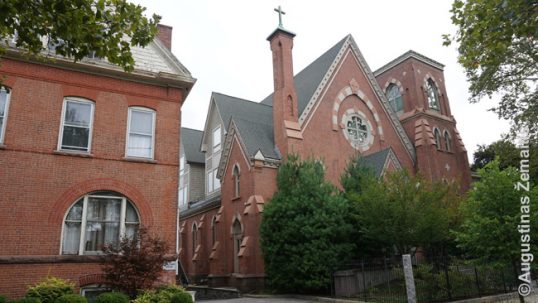
New Haven Lithuanian church
In the Northford suburb of New Haven there is an entire district with Lithuanian-named streets. It was developed by Lithuanian-American businessman who paved these streets and thus had a possibility to officially name them. The streets in question are Palanga Dr, Nida Dr (both famous Lithuanian resorts), Venta Dr (a Lithuanian river), and Ruta Dr (Rūta being both a Lithuanian female name and a Lithuanian word meaning "rue").

Venta Dr and Nida Dr in New Haven suburbs
Bridgeport Lithuanian church
Bridgeport St. George church is still operating and, in fact, open most of the time, making it one of the easiest Lithuanian churches to visit without a prior arrangement (also, it is the Connecticut Lithuanian church closest to New York). Inside, one could see more Lithuanian details than in many churches of Lithuania, including Lithuanian inscriptions about its benefactors incorporated into the stained glass windows, a Lithuanian chapel-post, Lithuanian words on the century-old altar cross ("Misijos atmintis 1913" - "Memory of a mission 1913"), Our Lady of Vilnius painting. All this despite the fact that the church is now mostly Hispanic.

Bridgeport St. George Lithuanian church
The St. George church of Bridgeport had its basement constructed in 1912. As was common with the Lithuanian-American churches, the construction continued above the basement and once the top of the church was built (cornerstone with both Lithuanian and English inscriptions dedicated in 1923) the basement was turned into a large hall for more secular affairs of the community.

Bridgeport Lithuanian church interior. Lithuanian flag on the right.
Before that, there had been a wooden Lithuanian chapel in Bridgeport since 1907. In a typical history of the era, the boundaries between Lithuanian and Polish communities were not clearly defined, and there used to be a Polish mass held for Polish-speaking Lithuanians, which the Polish priest from the Bridgeport's Polish parish asked to stop, claiming that all Polish-speakers are Poles and should come to his parish instead. The bishop supported the Polish priest establishing a linguistic boundary between, that is, Lithuanian-speaking and Polish-speaking parishes with not Polish mass allowed in Lithuanian parish and no Lithuanian mass in the Polish parish.
Map of Connecticut Lithuanian sites
All the Lithuanian locations, described in this article, are marked on this interactive map, made by the "Destination - America" expedition (click the link):
Map of Connecticut Lithuanian sites
Map of Lithuanian heritage in New England


Map of the Lithuanian heritage in New England (Connectictut, Massachusetts, Maine, Rhode Island, New Hampshire) and Quebec.
More info on Lithuanian heritage in Connecticut, Maine, Massachusetts, New Hampshire,
Rhode Island, Quebec.




